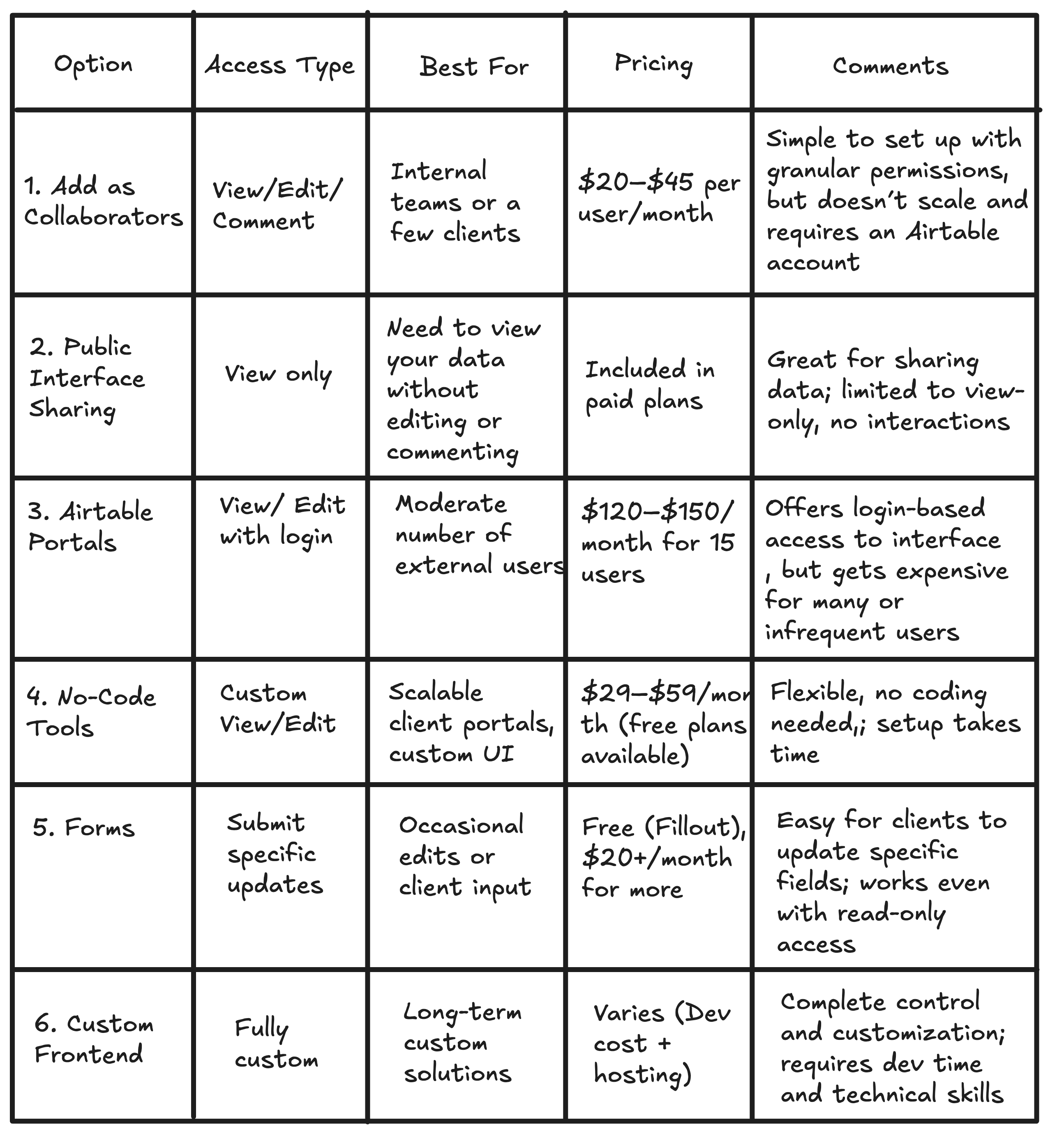6 Ways to Share Airtable Interfaces with Clients (Cost Breakdown)
You’ve organized your data in Airtable, and it’s working beautifully. Now you want your team or clients to view or even edit some of the data through interfaces.
Let’s break down your main options, from Airtable’s built-in features to third-party tools and clever workarounds. I'll also mention the costs involved, so you can choose what works best for your needs (and your budget).
1. Add Them as Collaborators (The Default Way)
The simplest method is to add your clients or team members directly to your Airtable workspace or base and assign them read-only, commenter, or editor access.
The downside is that every collaborator counts as a paid seat. For example, on the Team plan, you’ll pay around $20 per collaborator per month. On the Business plan, that cost jumps to about $45 per collaborator per month. If you’re only working with one or two clients, this might be manageable. But it doesn’t scale well.
Plus, this method doesn’t work at all if your clients are external and don’t have an Airtable account.
Note that read-only collaborators do not incur any additional cost and are included in all plans, regardless of which plan you're on. All plans include unlimited read-only collaborators.
2. Use Airtable’s Public Interface Sharing (Read-Only)
If your clients only need to view your data without editing or commenting, you can share a read-only version of your Airtable interface with them. This is perfect for dashboards and reports where they just need to see the information.
You’ll need to be on the Team plan or higher to enable public sharing, but there’s no additional cost beyond that.
Once it’s set up, you can simply send your clients a link, and they can view the interface without needing to log in or create an Airtable account. You can also embed the interface into a website, making it accessible to anyone.
3. Airtable Portals
Portals are a newer feature from Airtable that let you invite users to your interfaces without making them full collaborators.
With portals, you can create a custom login page for each client and give them access only to the interfaces you’ve set up for them.
Pricing starts at $120 per month for 15 portal users on the Team plan, and $150 per month on the Business plan. This option works well if you’re already on a paid plan and need to manage access for a moderate number of external users.
If you have many clients or your clients only need occasional access, this can become a rather expensive option.
4. Use No-Code Tools
If you want to avoid paying per client, using no-code tools like Softr, Stacker, Bubble, Noloco, and many others is a great option.
These tools let you build custom frontends, similar to Airtable Interfaces, without writing any code. You can easily connect them to your Airtable base to fetch data and display it on your frontend.
Now, when it comes to pricing, there are some differences worth noting.
Softr and Noloco do charge per client, but their pricing is still quite reasonable compared to Airtable, especially if you're building client-facing portals.
Stacker on the other hand, doesn’t charge per user. It uses flat-rate pricing, with the Pro plan starting at $349/month, which can actually be more cost-effective if you have a lot of clients.
Bubble works a bit differently. It doesn’t charge based on users at all. Instead, you pay based on the resources your app uses, which makes it a great choice if you're looking to build something scalable over time.
5. Use Forms
If your clients just need to update or edit specific records, forms can be a simple and effective solution.
Even in read-only Airtable Interfaces, you can add button fields that open forms, read-only users can still click buttons. You can use Airtable’s built-in forms for this, and I’ve actually written a detailed article on how to set it up.
That said, Airtable’s forms are pretty limited in terms of customization and flexibility. A much better option in many cases is Fillout. It integrates seamlessly with Airtable and offers a lot more control over the user experience. Best of all, it’s free for most use cases, with a very generous free plan. If you need more advanced features or higher usage limits, paid plans start at just $20/month.
If you want to let clients choose which record to update, Fillout’s “Choose a record to update” feature makes it super easy. Clients can select the record they need, and Fillout takes care of the update automatically.
Best of all, is free for most use cases.
6. Build Your Own Frontend
If you have access to a developer or some coding knowledge, you can build a custom interface using something like React or Next.js and connect it to Airtable via the API.
This gives you full control over how your data is displayed and who can access it. You can create login systems, edit forms, and dashboards—all tailored to your needs.
Summary

Need help or have feedback? Email me at[email protected]